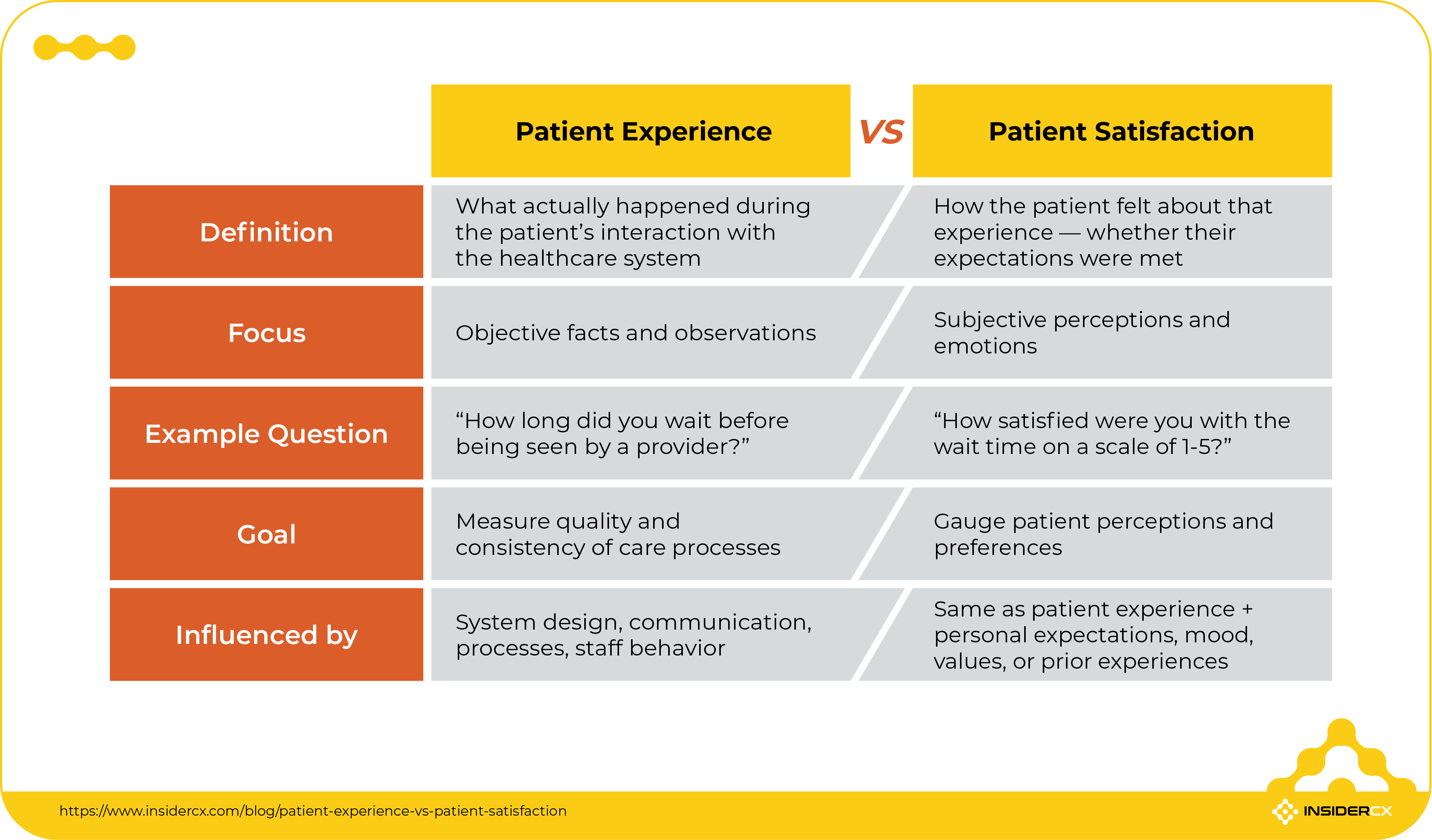“Happy patients” and “good care” sound like two sides of the same coin — at least until you start measuring them. That’s where many clinics trip up: they treat patient experience and patient satisfaction as synonyms, when they’re actually two distinct metrics telling two very different stories.
Let’s frame them like this:
- Experience is about what happened — what patients saw, heard, and went through as their care unfolded.
- Satisfaction is about how they felt about it — whether the experience matched their expectations.
Understanding this difference isn’t just semantics. It’s what lets quality managers spot the real weak points behind the numbers. Because a patient can be satisfied despite poor communication, but they can just as well be disappointed despite outstanding care.
This blog’s job is to explore the difference, trying to answer one simple question:
Should you focus on improving what happened or how it’s perceived? Hint: It’s both.
The differences between patient experience and patient satisfaction
Patient experience and patient satisfaction capture very different truths about the quality of care. Understanding where they diverge helps you decide which one to measure, when, and why.
Patient experience is an objective record of what actually occurred during care delivery. It looks at whether key processes and interactions met professional and operational standards. Its focus is not on how the processes and interactions made the patient feel, but whether they happened as they should have.
Examples of experience-based metrics:
- Clarity of provider communication
- Wait time before being seen
- Coordination between different staff members
- Follow-up instructions explained clearly
- Ease of scheduling appointments
- Timeliness of test results
- Clarity of billing or insurance information.
In contrast, patient satisfaction is a subjective evaluation of how the patient felt about that care. It reflects whether the experience met or missed their expectations. It’s a perception-based assessment influenced by emotion, comfort, and comparison with past experiences.
Examples of satisfaction-based metrics:
- Overall visit rating (1–5 stars)
- Likelihood to recommend the clinic (Net Promoter Score)
- Perceived friendliness, comfort, or convenience
- Sense of being heard or cared for
- Overall comfort of the environment (cleanliness, noise, privacy).

In simple terms, experience measures process reliability, while satisfaction measures emotional resonance.
You can deliver every procedure correctly and still fall short on satisfaction — or charm patients with warmth and still have serious process gaps. That’s why the real insight comes from tracking both.
Example: Same experience, different satisfaction
Let’s imagine two patients, both undergoing the same treatment at the same clinic, sharing an almost identical journey: same doctors, same nursing team, same treatment plan. Even the same clinical outcomes — a successful embryo transfer.
On paper, their experience was indistinguishable. Yet when their feedback comes in, their satisfaction scores and comments are quite different:
- The first patient described the process as “smooth, professional, and reassuring.”
- The second called it “stressful and emotionally draining,” noting that even though the staff were kind, she often felt left in the dark about what to expect next.
Here’s why what happens:
The first patient feels calm and reassured throughout the process, finding the staff supportive and the treatment steps clear. This patient reports high satisfaction because the experience met, or even exceeded, expectations.
Meanwhile, the second patient enters the process with higher anxiety and a stronger need for frequent updates. Although the care team maintains the same professionalism, this patient feels uncertain between appointments and is unsure about what happens next.
As a result, the second patient reports lower satisfaction — not because the experience was clinically deficient, but because communication did not fully meet their expectations for emotional support and clarity.
This contrast makes one thing clear: excellent care alone doesn’t guarantee high satisfaction. Both patients received the same medical attention, but only one felt guided and emotionally supported through it.
In this example, a clinic might find (by analysing feedback data) that a communication gap — and not clinical performance — was the real source of frustration. In response, they could introduce a new communication protocol: personal coordinators for each patient, structured updates after every key milestone, and clear next-step explanations at discharge.
How can clinics measure patient satisfaction and patient experience
Once you recognise that experience and satisfaction capture different realities, the next step is learning how to measure both effectively. Each requires a different kind of question, a different feedback loop, and a slightly different mindset.
Measuring patient experience
Experience is best measured through concrete, factual questions that capture what happened during the patient’s visit: Was the procedure clearly explained? Did you find parking near the clinic? How long did you wait for your appointment? Did you get after-care instructions?
These responses can be mapped along the patient journey to identify friction points across key touchpoints such as scheduling, arrival, consultation, and aftercare.
Beyond surveys, operational data fills in the gaps. Metrics like average wait times, response speed to calls or messages, and adherence to follow-up protocols provide an objective backbone for understanding how consistently the clinic delivers its standard of care.
And let’s not forget about feedback tools: SMS prompts, digital kiosks, or automated post-visit surveys. They ensure that experience data remains fresh, accurate, and linked to a specific moment in the patient journey.
Measuring patient satisfaction
Satisfaction requires a more interpretive approach. It’s measured through rating scales or Likert-style questions that capture how patients perceive the quality of service, the tone of communication, and their overall sense of comfort.
The Net Promoter Score (NPS) score often serves as the anchor, distilling the emotional outcome of a visit into a single, comparable metric.
However, satisfaction data shouldn’t live only in survey dashboards. Online reviews and sentiment analyses now provide a broader picture of public perception — how patients describe their experiences when they’re no longer responding to a structured form.
Tip: Use our Patient Rater to check patient reviews across the web and reveal your true reputation score, as well as precisely what patients think about your clinic (or a competitor's).
Once you begin integrating both direct and indirect feedback, you can track how perception shifts over time and understand which factors influence patients’ satisfaction scores the most.
Integrating both metrics
The most effective clinics don’t choose between experience and satisfaction, they align them:
- Experience data shows where the process succeeds or breaks down.
- Satisfaction data shows how those moments are remembered.
When combined, the two create a 360-degree view of performance, revealing correlations that single metrics miss. For example, long waits, unclear communication, or lack of follow-up can consistently depress satisfaction, even when clinical outcomes remain solid.
Using both datasets together allows quality managers to close the loop and improve the underlying experience to naturally raise satisfaction.
That’s why patient surveys should follow the patient journey and have dedicated questions that measure both experience and satisfaction.
If you want to refine your surveys and make your feedback data more meaningful, download our 100+ best-performing patient experience and satisfaction questions!

A better experience means better satisfaction
When clinics focus on improving the experience — the structure, clarity, and consistency of every patient interaction — satisfaction tends to follow. You can’t engineer emotions directly, but you can design the conditions that lead to them, moments that quietly build trust and shape how patients remember their care.
Together, experience and patient satisfaction form a complete feedback loop. It is exactly how leading clinics evolve — not by guessing what patients want, but by measuring it, understanding it, and acting on it.
Patient experience and feedback platforms, such as InsiderCX, help clinics measure satisfaction and experience through the automatic collection, analysis, and reporting of patient feedback across the entire patient journey.
If you need a tool that will help you collect feedback and reveal the story behind each score, schedule a quick demo with our team!




